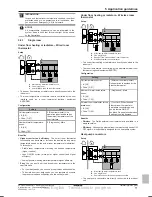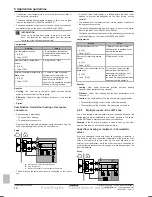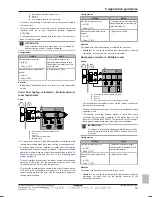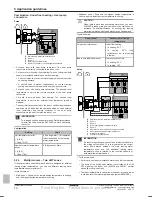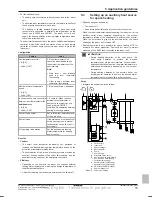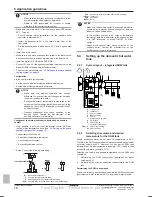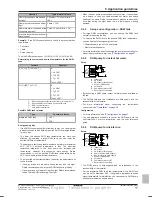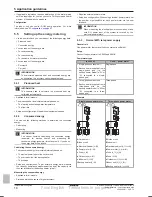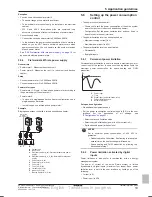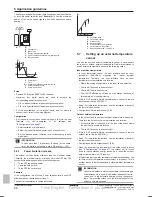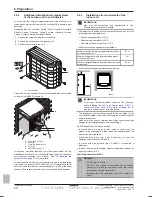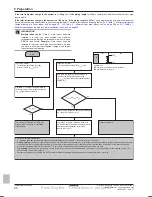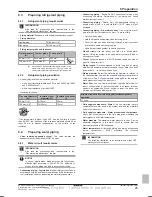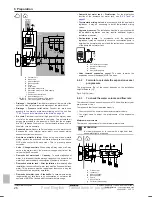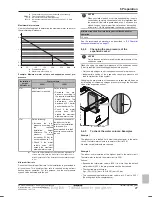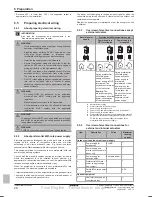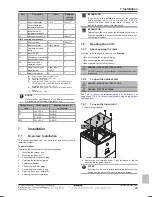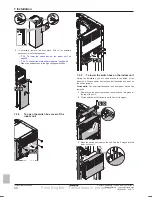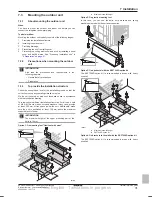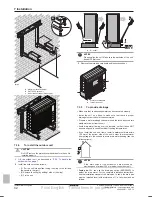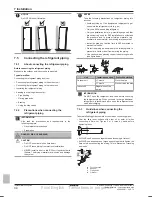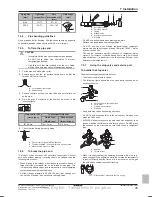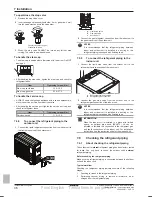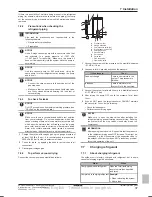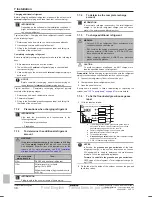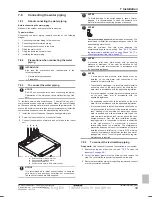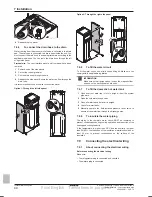
6 Preparation
Installer reference guide
25
ERGA04~08DAV3(A) + EHVH/X04+08S18+23DA
Daikin Altherma – Low temperature split
4P495248-1 – 2017.12
6.3
Preparing refrigerant piping
6.3.1
Refrigerant piping requirements
INFORMATION
Also read the precautions and requirements in the
"General safety precautions" chapter.
▪
Piping material:
Phosphoric acid deoxidised seamless copper.
▪
Piping diameter:
Liquid piping
Ø6.4 mm (1/4")
Gas piping
Ø15.9 mm (5/8")
▪
Piping temper grade and thickness:
Outer diameter
(Ø)
Temper grade
Thickness (t)
(a)
6.4 mm (1/4")
Annealed (O)
≥0.8 mm
t
Ø
15.9 mm (5/8")
Annealed (O)
≥1.0 mm
(a)
Depending on the applicable legislation and the unit's
maximum working pressure (see "PS High" on the unit
name plate), larger piping thickness might be required.
6.3.2
Refrigerant piping insulation
▪ Use polyethylene foam as insulation material:
▪ with a heat transfer rate between 0.041 and 0.052 W/mK (0.035
and 0.045 kcal/mh°C)
▪ with a heat resistance of at least 120°C
▪ Insulation thickness
Pipe outer diameter
(Ø
p
)
Insulation inner
diameter (Ø
i
)
Insulation thickness
(t)
6.4 mm (1/4")
8~10 mm
10 mm
15.9 mm (5/8")
16~20 mm
13 mm
Ø
i
Ø
i
t
Ø
p
Ø
p
If the temperature is higher than 30°C and the humidity is higher
than RH 80%, the thickness of the insulation materials should be at
least 20 mm to prevent condensation on the surface of the
insulation.
6.4
Preparing water piping
▪
Valve towards expansion vessel.
The valve towards the
expansion vessel (if equipped) MUST be open.
6.4.1
Water circuit requirements
INFORMATION
Also read the precautions and requirements in the
"General safety precautions" chapter.
NOTICE
In case of plastic pipes, make sure they are fully oxygen
diffusion tight according to DIN 4726. The diffusion of
oxygen into the piping can lead to excessive corrosion.
▪
Connecting piping – Legislation.
Make all piping connections in
accordance with the applicable legislation and the instructions in
the "Installation" chapter, respecting the water inlet and outlet.
▪
Connecting piping – Force.
Do NOT use excessive force when
connecting the piping. Deformation of the piping can cause
malfunctioning of the unit.
▪
Connecting piping – Tools.
Only use appropriate tooling to
handle brass, which is a soft material. If NOT, pipes will get
damaged.
▪
Connecting piping – Air, moisture, dust.
If air, moisture or dust
gets into the circuit, problems may occur. To prevent this:
▪ Only use clean pipes
▪ Hold the pipe end downwards when removing burrs.
▪ Cover the pipe end when inserting it through a wall, to prevent
dust and/or particles entering the pipe.
▪ Use a decent thread sealant to seal connections.
▪
Closed circuit.
Use the indoor unit ONLY in a closed water
system. Using the system in an open water system will lead to
excessive corrosion.
▪
Glycol.
For safety reasons, it is NOT allowed to add any kind of
glycol to the water circuit.
▪
Piping length.
It is recommended to avoid long runs of piping
between the domestic hot water tank and the hot water end point
(shower, bath,…) and to avoid dead ends.
▪
Piping diameter.
Select the water piping diameter in relation to
the required water flow and the available external static pressure
of the pump. See
"14 Technical data" on page 89
for the external
static pressure curves of the indoor unit.
▪
Water flow.
You can find the minimum required water flow for
indoor unit operation in the following table. In all cases, this flow
needs to be guaranteed. When the flow is lower, the indoor unit
will stop operation and display error 7H.
Minimum required flow rate during defrost/backup heater
operation
12 l/min
▪
Field supply components – Water.
Only use materials that are
compatible with water used in the system and with the materials
used in the indoor unit.
▪
Field supply components – Water pressure and temperature.
Check that all components in the field piping can withstand the
water pressure and water temperature.
▪
Water pressure.
The maximum water pressure is 4 bar. Provide
adequate safeguards in the water circuit to ensure that the
maximum pressure is NOT exceeded.
▪
Water temperature.
All installed piping and piping accessories
(valve,
connections,…)
MUST
withstand
the
following
temperatures:
INFORMATION
The following illustration is an example and might NOT
match your system layout.
Final English - Tanslations in progress

